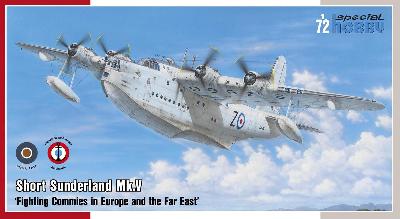Subtotal : 0 €
- Home
- Plastic model kits
- SHORT SUNDERLAND Mk. V - HEAVY SEAPLANA - RAF & FRENCH NAVY - 1945
SHORT SUNDERLAND Mk. V - HEAVY SEAPLANA - RAF & FRENCH NAVY - 1945
Description
The Short S.25 Sunderland was a British flying boat patrol bomber, developed and constructed by Short Brothers for the Royal Air Force (RAF). The aircraft took its service name from the town (latterly, city) and port of Sunderland in Tyne and Wear, North East England. Developed in parallel with the civilian S.23 Empire flying boat, the flagship of Imperial Airways, the Sunderland was developed specifically to conform to the requirements of British Air Ministry Specification R.2/33 for a long-range patrol/reconnaissance flying boat to serve with the Royal Air Force (RAF). As designed, it served as a successor to the earlier Short Sarafand flying boat. Sharing several similarities with the S.23, it featured a more advanced aerodynamic hull and was outfitted with various offensive and defensive armaments, including machine gun turrets, bombs, aerial mines, and depth charges. The Sunderland was powered by four Bristol Pegasus XVIII radial engines and was outfitted with various detection equipment to aid combat operations, including the Leigh searchlight, the ASV Mark II and ASV Mark III radar units, and an astrodome. The Sunderland was one of the most powerful and widely used flying boats throughout the Second World War.[2] In addition to the RAF, the type was operated by other Allied military air wings, including the Royal Australian Air Force (RAAF), Royal Canadian Air Force (RCAF), South African Air Force (SAAF), Royal New Zealand Air Force (RNZAF), French Navy, Norwegian Air Force, and the Portuguese Navy. During the conflict, the type was heavily involved in Allied efforts to counter the threat posed by German U-boats in the Battle of the Atlantic. On 17 July 1940, a RAAF Sunderland (of No. 10 Squadron) performed the type’s first unassisted U-boat kill. Sunderlands also played a major role in the Mediterranean theatre, performing maritime reconnaissance flights and logistical support missions. During the evacuation of Crete, shortly after the German invasion of the island, several aircraft were used to transport troops. Numerous unarmed Sunderlands were also flown by civil operator British Overseas Airways Corporation (BOAC), traversing routes as far afield as the Pacific Ocean. During the post-war era, use of the Sunderland throughout Europe rapidly declined, while greater numbers remained in service in the Far East, where large developed runways were less prevalent. Between mid-1950 and September 1954, several squadrons of RAF Sunderlands saw combat action during the Korean War. Around a dozen aircraft had also participated in the Berlin airlift, delivering supplies to the blockaded German city. The RAF continued to use the Sunderland in a military capacity up to 1959. In December 1960, the French Navy retired their aircraft, which were the last remaining examples in military use within the Northern Hemisphere. The type also remained in service with the RNZAF up to 1967, when they were replaced by the land-based Lockheed P-3 Orion. A number of Sunderlands were converted for use within the civil sector, where they were known as the Short Sandringham; in this configuration, the type continued in airline operation until 1974. Several examples were preserved, including a single airworthy Sunderland which has been placed on display in Florida at Fantasy of Flight. (Scale : 1/72e)- Brand:
- SPECIAL HOBBY
- Scale:
- 1/72
- Ref:
- SPE72162
- Category:
- Plastic model kits




